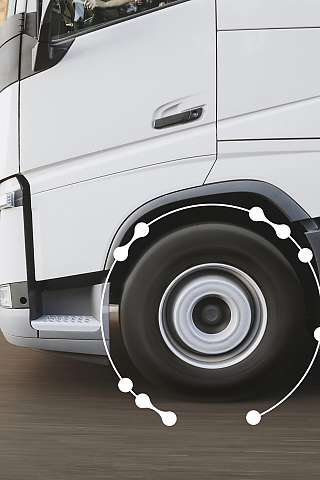What is Webfleet Tyre Pressure Monitoring System?
React fast to tyre inflation issues and eliminate downtime






Webfleet Tyre Pressure Monitoring System - 24/7 tyre control
Webfleet TPMS checks your tyre pressure and tyre temperature in real time. It offers predictive tyre management, so problems are detected before they lead to costly repairs or downtime.
Whatever you’re transporting – passengers or cargo – TPMS helps you ensure it gets to its destination safely and on time.
How do tyre pressure monitoring systems work?
Tyre pressure monitoring system means a system fitted on a vehicle which can evaluate the pressure of the tyres or the variation of pressure over time and transmit corresponding information to the user while the vehicle is running.
A TPMS reports air pressure information to drivers either through a gauge, a pictogram display or a simple low-pressure warning light on the dashboard.
When TPMS is used together with an online fleet management software. The measured pressure data of each wheel is sent to an online cloud administered by the fleet manager. In case of tyre under-inflation, a message can be sent to both the fleet manager and the driver of the vehicle so that the tyre can be inflated again.
Tyre pressure monitoring systems can be split into two categories: direct TPMS and indirect TPMS.
Direct TPMS
Direct TPMS monitors air pressure with hardware sensors, usually mounted in the wheel. It can even monitor tyre temperature readings. A direct tyre pressure monitoring system collects tyre data and transmits it to a centralised control module to be analysed, interpreted and then directed to the driver’s dashboard when tyre pressure is lower than it should be.
The benefits of direct TPMS include:
- Provides actual tyre pressure readings
- Is more precise than indirect TPMS
- Has a longer battery life (approximately a decade)
- Reset is not necessary even after tyre rotation and inflation
Disadvantages of direct TPMS:
- More expensive than indirect TPMS
- If the battery is drained, the entire sensor must be replaced
- Sensors may be damaged during mounting/demounting
Indirect TPMS
An indirect tyre pressure monitoring system does not measure physical pressure but uses software-based systems to evaluate and combine existing sensor signals such as the wheel speed, anti lock braking system, accelerometers and driveline data. When the vehicle has low tyre pressure, it will roll at a different wheel speed than other tyres. This will be detected by the software system and trigger the indicator light on the dashboard.
The benefits of indirect TPMS include:
- The wheel revolution rate measures tyre pressure
- Relatively inexpensive compared to direct TPMS
- Requires less maintenance over the years than direct TPMS
Disadvantages of indirect TPMS:
- When purchasing a bigger or smaller tyre, it may be inaccurate
- Reset after inflating of each tyre and routine tyre rotation required
- Potentially unreliable as tyres wear unevenly
Why do vehicles have tyre pressure monitoring systems?
As well as helping to ensure safe driving conditions, a TPMS offers predictive tyre management, so problems such as slow leak or abnormal tyre pressure are detected before they lead to costly repairs or downtime. When a tyre is running under inflation, it often consumes more fuel. Therefore keeping the tyre at its optimal pressure also helps save fuel and decrease tyre wear.
This, in turn, helps you to cut running costs, improve road safety and reduce your impact on the environment. And, with less chance of breakdowns, there’s less chance of service disruption.
It should also be noted that tyre pressure monitoring systems (TPMS) have been mandatory on passenger cars in Europe since 2014.

Advanced tyre technology: What does it mean for your fleet?

Our latest eBook deep dives into the new solutions, designs and materials optimising tyre performance and the potential impact on the sustainability, safety and cost effectiveness of your fleet.
Talk to a specialist
Your consent is required
In this section, external content is being embedded from .
To display the content, your consent is required for the following cookie categories:
- Targeted Advertising
- Analytics & Personalization
- Essential
For further details, please refer to our privacy policy. If you are interested in how ###vendor_name### processes your data, please visit their privacy policy.












